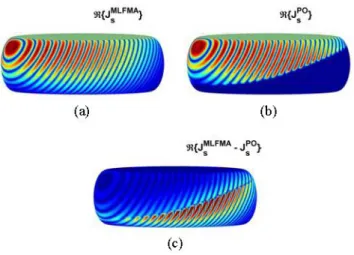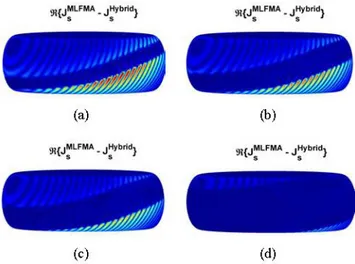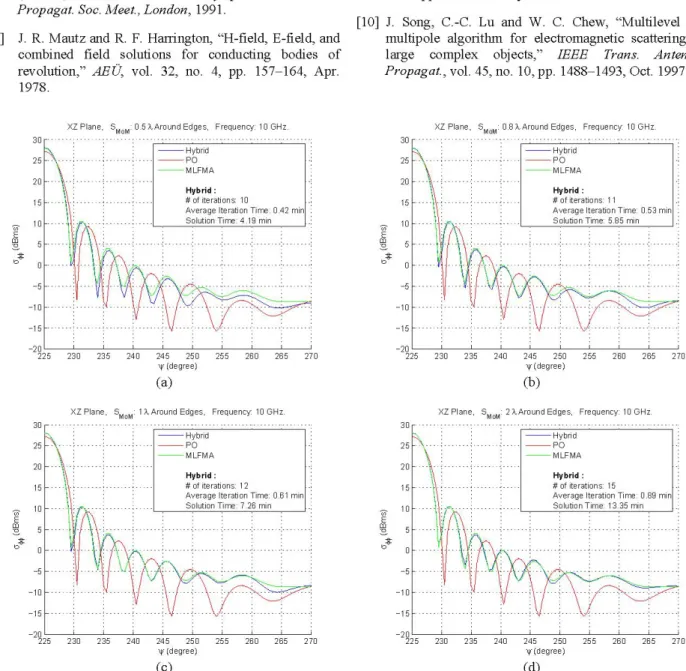PO-MLFMA
HYBRID
TECHNIQUE FOR
THE
SOLUTION OF
ELECTROMAGNETIC SCATTERING PROBLEMS
INVOLVING COMPLEX TARGETS
12 1212
L.
Guirell
,A. Manyas'
, 0.Ergiilt2
(1)Department
of Electrical and Electronics
Engineering
(2)Computational
Electromagnetics
Research Center
(BiLCEM)
Bilkent University, TR-06800, Bilkent, Ankara, Turkey
E-mail: {ergul, alp,
Igurel}@ee.bilkent.edu.tr
Keywords: Physical optics (PO), multilevel fast multipole algorithm (MLFMA), hybrid techniques, electromagnetic
scattering, radarcrosssection(RCS).
Abstract
The multilevel fast multipole algorithm (MLFMA) is a
powerful tool for efficient and accurate solutions of
electromagnetic scattering problems involving large and
complicatedstructures. Onthe otherhand, it is still desirable
to increase the efficiency of the solutions further by combining the MLFMA implementations with the
high-frequency techniques such as thephysical optics (PO). Inthis paper, we present our efforts in order to reduce the
computational cost of theMLFMA solutions by introducing
PO currents appropriately on the scatterer. Since PO is valid
only on smooth and large surfaces that are illuminated
strongly by the incident fields, accurate solutions require
careful choices of the PO andMLFMAregions. Our hybrid technique is useful especially when multiple solutions are
required for different frequencies, illuminations, and
scenarios, so that the direct solutions with MLFMAbecome
expensive. For these
problems,
we easily accelerate theMLFMA solutions by systematically introducing the PO
currents and reducing the matrix dimensions without
sacrificingthe accuracy.
1
Introduction
For the solution ofscattering problems involving large and
complicated targets, surface integral equations provide
accurate results when they are discretized appropriately by
using small elements (such as triangles) compared to
wavelength. Simultaneous discretizations of the integral equationsand the objects leadto dense matrixequationsthat
can be solved iteratively, where the matrix-vector
multiplications are accelerated by the multilevel fast
multipole algorithm (MLFMA). For an NxN matrix
equation,MLFMAperformsthe matrix-vectormultiplications
in
O(NlogN)
time usingO(NlogN)
memory. Due itslow complexity, MLFMA provides the solution of
electromagnetic scattering problemsinvolving large numbers of unknowns on relatively inexpensive computing
platforms [4]. On the other hand, most of the real-life problems require multiple solutions for different illuminations, frequencies, and scenarios. For these problems, it is desirable to accelerate the solutions by using fast but less accuratetechniques, such asthe physical optics
(PO). Inthe literature, there are many studies on developing hybrid techniques based on combining the method of moments (MOM) and PO technique to utilize both the accuracyof MOM and theefficiencyof PO for the solution of
scattering and radiation problems [2],[4],[7],[8]. In general,
these hybrid techniques are successfullyusedto improvethe accuracy of the PO solutions by introducing MOM in some
limited regions, where it is critical to account for the
electromagneticinteractions foraccuratesimulations.
In this paper, we present a robust hybrid technique, which involves the combination ofMLFMAand PO for the solution of scattering problems involving complicated structures.
Similar to the other hybrid techniques in the literature, we
employ integral equations for specific regions (MoM regions), such as the locations near the edges, cavities, and surfaces around the shadow boundaries, while the surface
currents in other (smooth) regions are approximated by PO.
The surface currents in the MOM region are solved by
MLFMA withalowcomplexity. To achieve adesired level
of accuracy with the minimum number of unknowns and
processing time,we systematically introduce the POcurrents
on the scatterer and reduce the dimensions of the matrix
equations solved by MLFMA. Effectiveness of this hybrid techniqueis demonstratedon ascattering problem involvinga
disc target with smoothedges.
2
Formulation
Weconsider scattering problems involvingthree-dimensional
conducting surfaces with arbitrary shapes. For a numerical
solution,surface of object is discretizedby usingsmallplanar triangles, onwhich the Rao-Wilton-Glisson(RWG)functions
[9] are defined to expand the unknown surface current
density, i.e.,
N
J(r)=
ar b(r),
where
a,,
represents the unknown coefficient of the nthbasis function br(r). When a scattering problem is formulateddirectly
by using
anintegral-equation
formulation,
simultaneous discretizations of the geometry and the integral
equation leadto NxN dense matrixequation, i.e., N
E
Z."a,
= V.n=l
(m
=
1,2,...,N).
Usingthe combined-fieldintegral equation (CFIE) [6],which is obtained by the combination of the electric-field integral equation (EFIE) and the magnetic-field integral equation
(MFIE), matrix elements in(2)canbe writtenas
Zmn.=
°ZEmn
, +(1
°-a)Z;n,
(3)
where
a,,,
representsacombination parameter between 0 and 1 for each m=1,2,..., N[3]. In(3),
contributions ofEFIE andMFIEarederivedasZEr
ik fdr tr (r) fdr' br(r')g(r, r')where q isthe waveimpedance, while
E"'
and Hnc arethe incident electric andmagnetic fields,respectively, duetothe externalsources.The matrix equation in (2) can be solved iteratively, where the matrix-vector multiplicationsare acceleratedbyMLFMA
[10]. For more efficient solutions, however, we propose a
hybrid technique based on approximating the currents on
smooth surfaces by using PO. In this technique, PO and MOM regions are determined on the object by considering
the trade-off between theefficiencyand accuracy. Toachieve a desired level of accuracy with the minimum number of unknowns and processing time, we apply MLFMA only on
such regionswhere the PO currents cannotprovide accurate
results. These regions usually correspond to the locations near the edges, cavities, and surfaces around the shadow boundaries. Forsmooth surfaces thatareilluminatedstrongly by the incident fields, we expandthe PO currents in aseries of basisfunctions, i.e.,
1 Npo
JPU
(r)
=-nxHznc
(r)
= Xa,br
(r),
2 n=l (8) S,f
dr tr (r).fdr'
br(r'). [VV'g(r, r')] Sm SI andZmn
=f-drtr(r) br(r) SI +fdr
tm(r) nxfdr'
br(r')xV'g(r,r'), SI SI(4) where coefficients of the basis functions (ar for
n= 1, 2, ...,
Npo
) canbe foundbytestingtheequationas1
~~~~~~~Npo
f
drt,
(r)
-xHrnc(r)
Idr tr(r) Ea,br(r) Sm Sm~ ~
n= Npoarn
dr t (r)br(r)
(1 = 1,2,...IN
)(5)
n=l (9) respectively, where k is the wavenumber, tr(r)
representsmth testing function, n is outward normal vector on the
surface,and
,)
exp(ik
r-r'1)
4gT4r-r'r' r (6)
This way,weobtainasparsematrixequationinthe form of
Npo
E
1Imn,
a,,n=l Wm (10)
where denotes the free-space Green's function in
phasor
notationusing
exp(iwt)
convention. In (4) and(5),
Sn and Sm represent the spatial supports of the nth basis function and mthtestingfunction, respectively. Using aGalerkinscheme,we choose the testing functions also asthe RWG functions.
Finally, in(2),elements of the excitationvector arederivedas
Vm
=-fdr
tr(r)
.a
Erc(r)
+(1
-)n
xHnc(r)]
(7)
SI' L V7Wm=-1
fdr
tr(r)nr
xH"c
(r)
,(1 1)
and (12)Ir
=fdr
tm(r)
* bn(r)
Sf
is the innerproduct ofmth testing and nth basis functions,
which is nonzero only when the functions
overlap
in space.Using RWG basis and
testing
functions,
Imr isextremely
sparseand the matrixequationin(10)
canbe solvedeasily
inafew iterations using a
Krylov subspace
iterativealgorithm
[1]. Sr;
After the coefficients in (10) are determined, the PO currents are radiated to the MOM region by performing a matrix-vectormultiplication, i.e.,
plot the difference between the real parts of the currents obtained by PO and MLFMA.
Npo
n=l
In
(13),
ym
for m=(Npo
+1),(Npo
+2),...,N corresponds
tothetesting of the radiated field due to the PO currents on the mth testing function located in the MOM region. The multiplication in (13) can be performed efficiently by employing MLFMA with reduced complexity. Then, the coefficients of the basis functions in the MOMregion can be calculatedby solving the matrix equation
N
s
Z,a
,v
(m=(N,
+1±)(N,,
+2),...,
N),
(14)
n=Npo+1
where
vT
=V -Ym (m=(N±o
+1),(N±o
+2),...,N)
(15)involves the testing of the incident fields due to both external
sourcesand the POcurrents.
The matrix equation in (14) can also be solved iteratively by
employingMLFMA.Usingthehybrid technique, dimensions of the matrix equation is reduced from NxN to
(N-
Npo)
x(N-Npo).
The extra cost is only due to thesolution of the extremely-sparse matrix equation in (10) to
expandthe POcurrents inaseries of basis functions and the matrix-vectormultiplication in (13) to radiate the PO currents
to the MOM region. Both of these operations require
negligible time compared to the iterative solution of (14). As
a result, by choosing the PO region appropriately, matrix dimensionscanbe reduced significantly [from (2)to (14)] to
accelerate the solutions withoutsacrificingthe accuracy.
3 Results
To demonstrate the accuracy and the efficiency of the proposed hybrid technique, Figure 1 presents a scattering problem involving a disc with smooth edges. The target is illuminated by a planewave propagating at
450
from the zaxis with the electric fieldpolarizedinthe y direction. The
problem is solved at 10 GHz and discretization of the geometry with A/10 mesh size leads to about 260,000 unknowns.
Figure 1.Ascattering problem involving a disc with smooth
edges. 9,01MLFMAj
(a)
(b)
WMi.FMA P0 9 J (c)Figure 2. Realpart of the surfacecurrent density inducedon the target depicted in Figure 1. (a) MLFMA. (b) PO. (c)
MLFMA-PO.
Figure 2 depicts the real part of the surface current density inducedonthe target shown inFigure 1. Comparing Figure
2(a) and 2(b), we observe that the currents obtainedby PO differ significantly compared to the currents obtained by
MLFMA especially around the shadow boundary. The
inaccuracyof PO is also illustrated inFigure 2(c),where we
Tofurtherinvestigatethe accuracy of the PO solution, Figure 3 presents the bistatic radar cross section (RCS) values in decibels (dBms) as afunction of bistatic anglefrom 225° to
270° on the z-xplane, where 225° corresponds to the
forward-scatteringdirection. Weobserve that the PO solution is inaccuratecomparedtothe reference solutionbyMLFMA.
(m
=(N,,
+1), (N,,
+2),...,
N).
(I3)
XZ Plane, Frequency: 10GHz. PO MLFMA MLFMA: # of iterations: 27
Average Iteration Time: 1.77 min Solution Time 47.83 min
M{JMLFMA- Hyb 4{-MLFMA JF4ybrid}S S
(a)
(b)
9g4MLFMA jbrldj A(JMLFMA JHYbrid)
225 230 235 240 245 250 255 260 265 270
ir (degree)
Figure 3. Bistatic RCS of thetargetinFigure 1 calculated by
MLFMAand PO.
TheMLFMAsolution of the scattering probleminFigure 1 is
performed in about 48 minutes on an AMD Opteron processor. In order to reduce the processing time without
loosing the accuracy, we employ the hybrid MLFMA-PO
technique by systematically introducing PO currents on the
object. This is achievedby using POcurrents onthe lit and
shadow regions while keeping the MLFMA on the shadow
boundary (MOM region). By adjustingtheareaof the MOM
region, we examine the trade-off between the efficiency and accuracy. InFigure 4,wepresenttheerrorof the solutionsby
plotting the difference between the currents obtained by the hybrid technique and the reference MLFMA. It can be
observed that the currents obtained by the hybrid technique
becomes more and more accurate as the MOM region is
enlarged. This is also confirmedbythe RCS plotsinFigure
5. UsingMLFMA ina narrowregiondiscretized with 19,500
unknowns, we obtain the solution inonly about 4.2minutes,
while the results are close to the reference solution as
depictedin Figure 5(a). Then, by increasing the area of the
MOMregion,accuracy of the resultscanbe furtherimproved asdepictedinFigure 5(b), Figure 5(c),andFigure 5(d),while
the solution time increases. Ingeneral, the choice of thePO
and MLFMA regions depends on the desired level of
accuracyand theefficiency requirements.
(c) (d)
Figure 4. Error in the real part of the induced currents
obtained by the hybrid technique compared to reference
MLFMA solution. (a) SMOM: 0.5k around edges with 19,500
unknowns. (b) SMOM : 0.8k around edges with 31,050
unknowns. (c)SMOM: 1karoundedgeswith39,750unknowns.
(d)SMOM: 2k aroundedgeswith82,500unknowns.
Conclusion
We present a robust hybrid technique for the solution of
scattering problems involvingthree-dimensional complicated targets. Our strategy is based on introducing PO currents systematically on thetarget to reduce the dimensions of the
matrix-equation solved by MLFMA. Weconsider the
trade-off between the accuracy and efficiency of the results by
adjustingthePO and MOM regions carefully. Thisway, we
are able to accelerate the solutions without sacrificing the
accuracy.
Acknowledgements
This work was supported by the Scientific and Technical
Research Council of Turkey (TUBITAK) under Research
Grant 105E172, bythe Turkish Academy of Sciences in the
framework of the Young Scientist Award Program
(LG/TUBA-GEBIP/2002-1-12),
and by contracts from ASELSAN and SSM.References
[1] S. Balay, K. Buschelman, V. Eijkhout, W. D. Gropp,
D.Kaushik,M.G.Knepley,L.C.McInnes,B. F. Smith,
and H.Zhang,PETSc UsersManual, Argonne National
Laboratory,2004.
[2] D. B. Bouche, F. A. Molinet, and R. Mittra,
"Asymptotic andhybrid techniques for electromagnetic scattering,"Proc. IEEE,vol. 81,no. 12,pp. 1658-1684,
1993. 30 25 20 15 10 5 0 E m -5 -10F -15 -ZU
[3] L. Guirel and
0
.Erguil, "Extendingthe applicability ofthe combined-field integral equation to geometries containing open surfaces," IEEE Antennas Wireless Propagat.Lett., vol. 5, pp. 515-516, 2006.
[4] L. Guirel and
0.
Erguil, "Fast and accurate solutions of integral-equation formulations discretised with tens of millions of unknowns,"Electronics Lett., vol. 43, no. 9,pp.499-500,Apr.2007.
[5] C. S.Kim and Y.Rahmat-Samii, "Low profile antenna
study using the physical optics hybrid method (POHM)," Proc. IEEE Int. Symp. Antennas and
Propagat.Soc. Meet.,London, 1991.
[6] J. R. Mautz and R. F. Harrington, "H-field, E-field, and combined field solutions for conducting bodies of revolution," AEU, vol. 32, no. 4, pp. 157-164, Apr.
1978. 25 20 15 10 en E 5 0
XZPlane, SMoM 0.5kAroundEdges, Frequency: 10 GHz. Hybrid
MLFMA
Hybrid
,,\... .... .. .. #ofiterations:10
Average Iteration Time: 0.42 min SolutionTime: 4.19min
[7] L. N. Medgyesi-Mitschang and D. S. Wang, "Hybrid
solutions for scattering from perfectly conducting bodies of revolution," IEEE Trans. Antennas Propagat., vol. 31, pp. 570-583, July 1983.
[8] P. K. Murthy, K. C.Hill, andG. A. Thiele, "A
hybrid-iterative method for scattering problems," IEEE Trans. AntennasPropagat., vol. 34, pp. 1173-1180, Oct. 1986.
[9] S. M. Rao, D. R. Wilton, and A. W. Glisson, "Electromagnetic scattering by surfaces of arbitrary shape," IEEE Trans. Antennas Propagat., vol. AP-30, no. 3, pp.409-418, May 1982.
[10] J. Song, C.-C. Lu and W. C. Chew, "Multilevel fast multipole algorithm for electromagnetic scattering by large complex
objects,"
IEEE Trans. Antennas Propagat.,vol. 45, no. 10, pp. 1488-1493, Oct. 1997.30-25 20 15 10 en E 005 -10 -15 -10 -15 -20 225 230 235 240 245 250 255 260 265 270 -20225 v(degree)
(a)
XZPlane, SMoM 0.8X AroundEdges, Frequency: 10 GHz.
Hybrid
..
MLFMA
Hybrid: #.ofiterations:11
AverageIterationTime: 0.53 min SolutionTime: 5.85min
230 235 240 245 250 255 260 265 270
v(degree)
(b)
XZPlane, SMoM 1X AroundEdges, Frequency: 10 GHz.
.. ... .. .. .. .. .. .. ... .... Hybrid .,... MLFMA Hybrid: \-;.---..;... ; # of iterations: 12
AverageIterationTime: 0.61 min
... SolutionTime: 7.26min
E 30 25 20 15 10
XZPlane, SMoM2kAroundEdges, Frequency: 10 GHz.
... ... .. .. .. .. .. .. .. . Hybrid P0 MLFMA Hybrid: ;... #ofiterations:15
AverageIterationTime: 0.89 min SolutionTime: 13.35min
-10 -15 -20 _ 230 235 240 245 250 255 260 265 270 225 v (degree) (c) 230 235 240 245 250 255 260 265 270 v(degree) (d)
Figure 5. BistaticRCS of thetargetinFigure 1 calculated byMLFMA,PO, and the hybrid technique. (a)SMOM: 0.5k around
edgeswith 19,500unknowns. (b) SMOM: 0.8karound edgeswith31,050unknowns. (c) SMOM: 1X around edges with39,750
unknowns. (d)SMOM: 2karoundedgeswith82,500unknowns.
30-25 20 15 10 E -5--10 -15 -20_ 225


